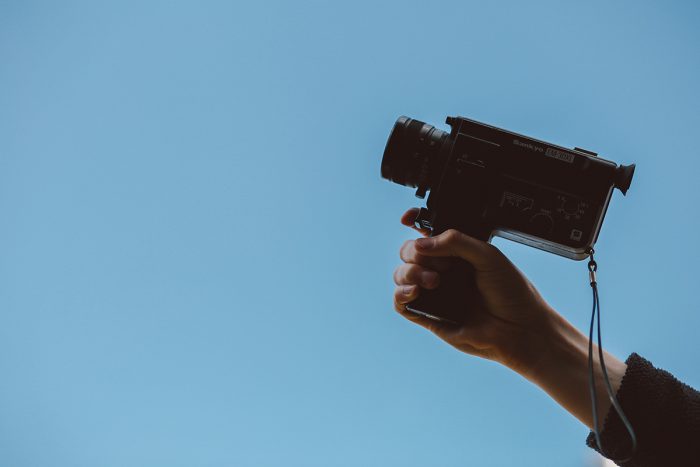
Filmmakers — Stop Seeking Technical Perfection
Why filmmakers should stop obsessing over the latest camera technology.
Robert Capa’s photograph of a soldier struggling ashore during the D-Day landings is perhaps the greatest ever taken. Blurred almost to the point of abstraction, The Face in the Surf (1944) undoubtedly proves that technical perfection is unnecessary in art or storytelling. The viewer is able to establish the situation from just a glance: war, the two-fold danger posed by bullets and the sea; one can practically feel the noise and chaos of battle. The photograph also reveals the true abject horror of human conflict: in stark contrast to the celebratory and triumphant images of upright, heroic men in the likes of V-J Day in Times Square (Alfred Eisenstaedt, 1945) and Joe Rosenthal’s Raising the Flag on Iwo Jima (1945), Capa’s subject must crawl on his belly in the sand and water. Whilst Eisenstaedt and Rosenthal’s photographs are technically superior to Capa’s, in their sharpness, this does not detract from the impact of the beach landing image. The story is intact despite, or perhaps because of, its technical flaws. Below, I will explore how we can learn lessons on technical [im/]perfection in cinema from this photograph, via a selection of films from the past thirty years.
Perhaps the easiest argument to make regarding technical perfection in cinema is that it is simply unnecessary for affective storytelling. A great, well-told story is a great, well-told story, regardless of production values. This adage may be considered something of a cliché by many readers familiar with its currency on blogs like this: a broad statement with little to no evidence to support it. However, examining Jonason Pauley’s 2013 Live Action Toy Story, a YouTube-released, unauthorised shot-for-shot remake of the 1995 Pixar classic utilising real-life versions of the featured toys, will prove this to be true. As low fidelity a production as the cheapest home video, almost every shot is soft, poorly exposed, or clumsily composited. It is definitely not HD, let alone 4K. Yet the shot composition and staging is the same, and the original audio is synced with Pauley’s home-shot footage, meaning we get Tom Hanks, Tim Allen, and the rest of the original cast’s voice performances, barring the human characters who are played by real-life humans. Resultantly, this do-it-yourself remake hits every emotional beat in a way that is as thrilling and absorbing as the original Toy Story. Even when scrubbing through the film whilst researching this article, I found myself drawn in: watching more than the couple scenes I had intended to view. Other than the image quality and live-action nature of the remake, it is identical to the original Toy Story, suggesting that even if the source material were this amateur-looking, it would remain as effective and affective as it actually is.
Live Action Toy Story, directed by Jonason Pauley, 2013
Further evidence for technical perfection’s irrelevance in traditional, illusionist filmmaking comes from the excellent iPhone-shot Tangerine (Sean Baker, 2015). The dynamic range of the images is extremely limited, with highlights clipping and shadows crushed, which is said to have prompted the filmmakers to build the strongly-stylised look the film is known for: strong tones of gold contrasting with over-saturated blue skies foregrounding the titular shade of orange. Seen on a 4K monitor in 2018, the image starts to fall apart, with limited detail, plenty of noise, and visible pixellation. Yet, of course, the film is a fantastic, sympathetic look at the lives of trans sex workers Sin-Dee and Alexandra as they search for the former’s unfaithful pimp/boyfriend, Chester, across the LA landscape. The film’s strength is in its storytelling, with the screenplay and plot developed in collaboration with its trans cast, so that it never feels exploitative or voyeuristic. The film’s being shot on an iPhone turned out to be a fantastic marketing angle for Tangerine but this does not affect the storytelling — once again, the film is a good film because it is a good film.
Trailer for Tangerine (Sean Baker, 2015)
An alternative reading of the film’s lo-fi, stylised look could be to see it as a distancing effect of sorts, encouraging the viewer to engage more critically with its content. This is certainly how I read films of the Dogme 95 movement. For those unfamiliar, Dogme 95 was an approach to filmmaking officially lasting from 1995 to 2005, founded by Danish filmmakers Lars von Trier and Thomas Vinterberg. A radical response to the hegemony of Hollywood spectacle and high budgets, the founders set out ten rules in a ‘Vow of Chastity’, including forbidding “special lighting” of scenes, the use of tripods or other grip equipment, and the presence of “superficial action” (murders more specifically). There is a conscious rejection of the “illusion” of conventional filmmaking, and “by its minimized aesthetic and even more so by the insistence on hand-held camera, Dogma 95 ensures that the audience is made aware of the film as an artifact and thereby of the implied mise-en-scene and filming.” The dominant visual language is similar to that of documentary filmmaking: frenetic camera movement, low image fidelity, ungraded cheap analogue or digital video rendering every scene un-beautiful.
Trailer for Festen (Thomas Vinterberg, 1999)
Ironically then, the Dogme effect, despite its realist, cinéma-vérité aesthetic, has much in common with the Brechtian Epic Theatre. The low-fidelity, shaky, often poorly-framed or unfocused cinematography of such films as Festen (Thomas Vinterberg, 1999) goes far to disrupt the viewer’s passive consumption of the film as material truth, prompting them to consider that they are watching a construct just as Brecht wished to show the ropes and pulleys of the theatre stage. The images do not look like ‘cinema’, the flaws in the images arguably prompting the viewer to confront the fact that they are watching a film. In the case of Dogme 95, this is an act of resistance to American cultural hegemony; in the case of distancing devices in the films of the likes of New German filmmakers Straub-Huillet or Rainer Werner Fassbinder it is a means of conveying a political message.
To summarise this into simple prose, technical imperfection can be a powerful tool, one that has been used by political filmmakers, theatre practitioners, and artists throughout the twentieth century to disrupt the mainstream and encourage viewers to engage intellectually and critically with their productions, rather than simply responding emotionally sans reflection. This rests quite heavily on Walter Benjamin’s notion that art must be difficult and use new languages to elicit change. If the audience is simply a passive viewer, reactive rather than proactive in seeking meaning, the likes of Benjamin and Brecht would argue, art cannot elicit social change. Furthermore, how can a film stimulate revolution if it simply emulates the language of an oppressive, dominant culture? These are issues that can be explored and opposed through the deliberate use of technological and aesthetic imperfection.
Thomas Vinterberg on the establishment of the Dogme Vow of Chastity and the making of Festen.
Ultimately, then, filmmakers need not obsessively seek technical perfection for their films. Whether hampered by budgets or making a conscious choice to use lesser equipment, these filmmakers have proven the reality that good images do not necessarily a good film make. Live Action Toy Story or Tangerine show that a lo-fi approach can be married with affective, conventional storytelling, whilst Dogme films such as Festen use it to make a political statement. To fully investigate the power of lo-fi filmmaking as affective storytelling though, one must look beyond Live Action Toy Story, as a question arises over how much the film utilises the viewer’s nostalgia and familiarity with a pre-existing, popular text to elicit affective responses. To prove its ability to move viewers, one would have to screen it to an audience who have never seen the Pixar original, and measure their responses against an audience watching the animated Pixar version for the first time, analysing the data in a semi-quantitative study. Leaving aside technical imperfection as distancing device (as it is difficult to find examples of Dogme short films), as a post-script I recommend the following short film from the Duplass brothers, which ticks the boxes of low production values and high affect:
Scrapple (Jay Duplass and Mark Duplass, 2004)
Further Reading
Adorno, Theodor W, et al. Aesthetics And Politics. Reprint, London: Verso, 2007.
Benjamin, Walter. The Work Of Art In The Age Of Mechanical Reproduction. Translated by James Amery Underwood. Reprint, London: Penguin Books, 2008.
Brecht, Bertolt. Brecht On Theatre, Edited by Marc Silberman, et al. Reprint, London: Bloomsbury, 2014.
Higgins, Jackie. Why It Does Not Have To Be In Focus. Reprint, London: Thames & Hudson, 2013.



